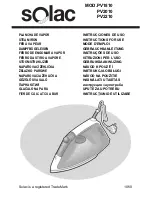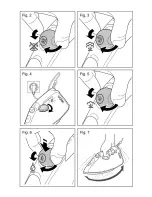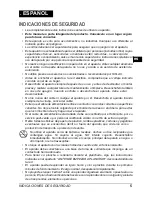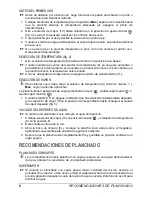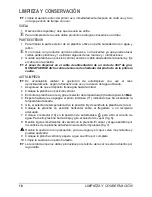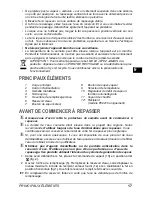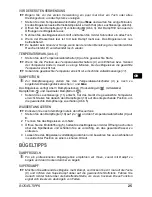
12
MAIN COMPONENTS
•
Always store the iron in a vertical position on its stand, resting it on a stable surface.
•
The iron must not be used if it has been dropped, or if there is any crack or leak in the
water tank. If you observe any of these problems, take the iron to a T.A.S. approved by
the manufacturer.
•
Do not leave the appliance unattended when switched on.
•
The soleplate can get very hot when the appliance is in use. During operation, do not
touch the soleplate and only hold the iron by its handle, and ensure the cord does not
come into contact with the soleplate
q
CAUTION! When you want to dispose of the appliance, NEVER throw it in the
rubbish bin. Take it to the CLEAN POINT or waste collection centre closest to your
home for processing. You will thus be helping to take care of the environment.
MAIN COMPONENTS
BEFORE STARTING TO IRON
,
Always make sure the soleplate protector has been removed before starting to
iron.
,
Due to the high levels of mains water hardness in most areas, Solac recommends that
you
always use demineralised water for ironing
. In this way, you will guarantee that
your iron remains in optimal condition for a longer period of time.
,
If, for any reason, you cannot find demineralised water, please ensure you use water
with a low mineral content (soft water), or filter tap water using a water filter.
,
Do not use decalcifying agents or descaling products in the water tank. Do not
use scented water or ironing water either. These products damage the interior of
the steam generation system.
1 With the iron unplugged from the mains, rotate the steam selector (10) to the closed
position
(fig. 2).
2 Open the water filler opening (5). Fill the water tank without exceeding the maximum
level, using the water beaker provided (12) and keeping the iron in the vertical position
(Fig. 1). When the tank is full, close the cap.
)
When filling the tank, make sure that the water does not overflow from the water filler
opening.
3 Check whether the garment to be ironed has a label indicating the ironing temperature.
)
We recommend you classify the garments according to their required ironing
temperature and begin with the garments ironed on the lowest temperature (•).
,
NOTE: Ironing delicate garments at a temperature higher than necessary spoils the
fabric and causes burnt residue to stick to the soleplate.
1
Main body
2
Power cord
3
Metal soleplate
4
Spray outlet
5
Water filler opening
6
Water tank
7
Spray button
8
Supersteam button
9
Temperature selector
10
Steam/Self-clean selector
11
Temperature pilot light
12* Water beaker (only model PV2210)
SYNTHETIC FIBRES, minimum temperature (•)
SILK, WOOL, medium temperature (••)
COTTON, high temperature (•••)
LINEN, MAX temperature

